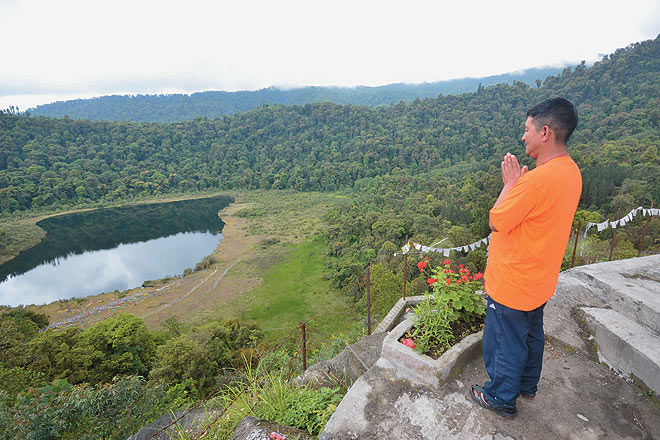Khecheopalri Lake, Sikkim
This beautiful lake, about 140km from Gangtok, is one of Sikkim’s hidden jewels. It’s
More on Outlook Traveller: Here’s an account of our visit to Khecheopalri lake.

Tso Moriri, Ladakh
Pictureque, serene and alluring, the TsoMoriri is probably the most ecologically wealthy high altitude lakes in our country. The remoteness of the lake, deep inside the Changthang plateau and ringed around with some of Ladakh and Spiti’s highest peaks, has managed to keep it relatively inviolate. Measuring about 120 sqkm, TsoMoriri is a huge lake and although the water is brackish and mostly devoid of any nutrient content, it hosts an impressive variety of bird and animal life. The surrounding areas of the lake are home to snow leopards, Tibetan antelopes called kiang as well as wolves. The lake is an excellent nesting goround for various avian speicies, and this attracts several species of migratory birds such as the endangeredblack-necked cranes and bar-headed geese. The Changthang Plateau is also home to the nomadic Changpa people and their large herds of pashmina goats.
More on Tso Moriri on Outlook Traveller: Read about our trek through Changthang to Tso Moriri.

Chilika Lake, Odisha
Asia’s largest brackish lagoon, the Chilikalake, has become synonymous with a fascinating, aquatic creature facing a stiff battle for survival—the Irrawaddy dolphin.More than a hundred individuals call the waters of the lake their home, along with the even more rare bottlenose dolphins.Also inhabiting the lake are species such as stingrays, hammerhead sharks, requiem sharks and Murray eels. The ecosystem, however, is under massive pressure from the fishing as well as tourism industries, but this doesn’t seem to deter the white-bellied sea eagles, greylag geese, purple moorhen, jacana, flamingos, egrets and gray and purple herons from establishing their territories in these waters. A tourism hotspot, Chilika is also rich but fragile ecological hotspot.
More on Chilikaon Outlook Traveller: Read about the time we rode a cycle rickshaw to Chilika.

Loktak Lake, Manipur
A floating national park might sound too fantastic but believe it or not, that is a pretty good definition of Loktak lake. The largest freshwater lake in the northeast of the country, Loktak is home to a highly endangered species of deer called sangai or the dancing deer. The species is endemic to one of the floating biomasses, or a phumdi. The phumdi on which the sangai reside has been designated as the Keibul Lamjao National Park. The park occupies an area of 40 sqkm and contains a population of around 200 sangai; three-fourths of the park is submerged. Apart from the sangai the park is also home to other elusive mammal species such as the marbled cat and the Temminck’s golden cat. The place is also a birder’s delight, as it is home to the brown-backed hornbill, the rufous-necked hornbill, the wreathed hornbill, the pied hornbill and the great pied hornbill. Loktak is at a distance of 53 kilometers from Manipur’s capital city, Imphal.

Nalsarovar Lake, Gujarat
This 123 sq km lake is one of the largest lake-based bird sanctuaries in the country. The Nalsarovar lake attracts a formidable variety of migratory birds in the winter months, and along with resident species, that add up to an impressive 250 different avian species. Most of the lake comprises of marshlands, and this attracts migratory birds such as rosy pelicans, flamingos, white storks and Brahminy ducks. The lake’s environment acts as a perfect feeding and nesting ground for these birds. It goes without saying then that the lake is a birdwatchers’ paradise. But that’s not all: the area adjacent to the park is home to blackbucks and the endangered wild asses, the latter has been classified as an endangered species as per the IUCN.
Chilika lake
flamingos
Gujrat


